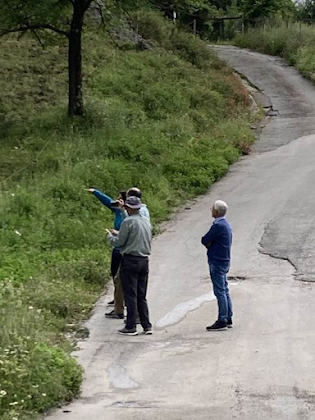63. Joseph Louis Mott's Naderman harp
Sarli Journal
Joseph Louis Mott AKA Rocco Vincenzo Sarli (1857-1894)—his ancestors and his descendants
Monday, 23 December 2024
Wednesday, 2 August 2023
60.
Sarli Home in Laurenzana (part 2)
by Dr. Joseph Mott
59.
The Sarli Home in The Country (part 1)
by Dr. Joseph Mott
On Saturday, June 10, 2023, Giovanni De Carolis led us to a rural property just outside of the village of Laurenzana. Adam, Fernanda, Christopher, Julieta, and I got out of the car. It had been raining some, and we climbed over what looked looked like an electric wire fence, but we didn’t get shocked. We started up a little hillside. The ground was pretty wet, and there were a lot of clumps of grass, but dirt between, sort of a slippery clay, making it difficult to walk or climb up the hill. We all managed to reach the top of the hill, but did not find any buildings or ruins of buildings. Lower down on the hill, it looked washed out, and there was water seeping from the ground. Someone had put a new black plastic hose, about 1 1/2 inch in diameter, into the hill where the water was seeping. The hose ran down the hill further, across a little stream, and then up onto the property beyond a fence on the other side. I surmised that someone had tapped a spring for water. I was interested in seeing this because Grandpa Mott reportedly lived close to a spring or stream in a rural area. One account mentioned the possibility of a spring running under the house. In any event, we did not see any ruins of a house in the washed out area. In fact, it was not a good locale for a house because of the rough terrain. The stream was small, but probably could carry a lot of water in the wet season. Someone had constructed dams (we saw two), out of large masonry blocks, each with a broad spillway in the middle. Perhaps they wanted to form small pools.
Sunday, 18 June 2023
58.
Dr. Joseph Mott visits Laurenzana
Dr. Joseph Mott, his son Adam and daughter-in-law Fernanda with their two children, visited the Province of Potenza June 8 -11. On June 8, they stayed overnight in Viggiano. During the day, Giovanni Antonio De Carolis, his wife Antonietta, and translator Annalisa Pisillo drove from Laurenzana and met with the Mott's for the very first time at their hotel in Viggiano.
L to R: Dr. Joseph Mott, Annalisa Pisillo, Antonietta Martoccia, Giovanni De Carolis, Adam Mott
Giovanni is the grand-nephew of Maria Carmela Sarli (1898-1990), daughter of Vito Maria Sarli (1855-1944) who was the brother of Rocco Vincenzo Sarli AKA Joseph Louis Mott (1857-1894). As a boy growing up in Laurenzana, Giovanni knew and dearly loved Maria and her husband Luigi Policarpio De Carolis (1899-1980).
Now Giovanni works for the city of Laurenzana and his wife is a math teacher. They are the parents of two grown sons, Rocco and Marcello, who both live and work in Potenza. Rocco is a security guard and Marcello is a high school music teacher who is gaining fame as a classical guitarist and virtuoso of the chittara battente.
Tuesday, 11 April 2023

Mary "Kathleen" (Mott) Jefferson of Grand Junction, Colorado passed away peacefully at the age of 85 on April 5th in the presence of loved ones. Kathleen was born May 31st, 1937 in Alamosa, Colorado to her parents Elsie (Sowards) and Jacob Mott. She was the 9th of 12 children.
Kathleen was raised in Alamosa and attended Adam State College, where she proudly represented the school as a cheerleader. While at Adam State, Kathleen met her husband of 66 years, Jay Jefferson, and they were married January 26, 1957.
In 1966 Kathleen and Jay set roots in Grand Junction. She began her first years in Grand Junction as a homemaker raising her 2 children. In 1972 she began her career with Mesa College as a Residence Hall Director. Later she was assigned the duties of Assistant Housing Director and ultimately served as Housing Director until her retirement. In retirement, Kathleen enjoyed spending time in her home, working in her flower garden, and being visited by family.
Kathleen was an active member of The Church of Jesus Christ of Latter-Day Saints where she graciously and proudly served others in their times of need.
Kathleen is survived by her husband John W. "Jay" Jefferson of Grand Junction, CO; son Kendall (Jennifer) Jefferson of Lindon, UT; their four children: Lindsey (Justin) Reed, Andrew (Claire) Jefferson, Parker Jefferson, Samuel Jefferson, and 6 great grandchildren; daughter Jill (Deryl) McKinnerney of Hondo, TX; their 3 children: Taylor Rae McKinnerney, Monty McKinnerney (deceased), and Nathan McKinnerney. She has three surviving siblings: Donna "Betty" Turney of Alamogordo, NM, Dr. Joseph Mott of Chandler, AZ, and Jeannie Brandis of Flagstaff, AZ.
A memorial service will be held at a date to be announced.
Please express your condolences at this site: https://www.dignitymemorial.com/obituaries/grand-junction-co/mary-jefferson-11237284/add-memory















